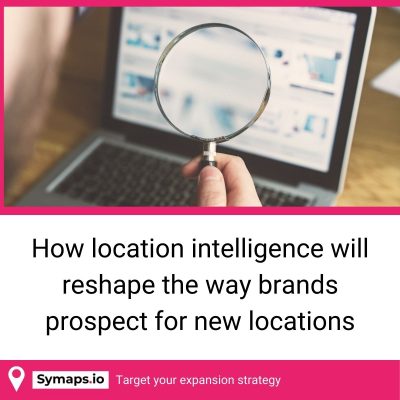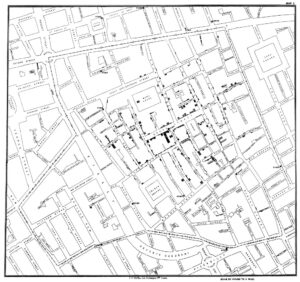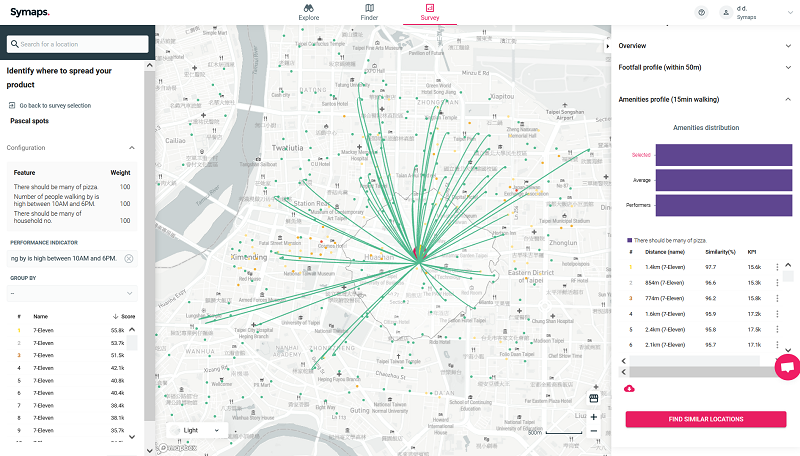How location intelligence will reshape the way brands prospect for new locations
- September 1, 2022
- 4 min read
As a preamble, do you know what does the handle of a public fountain in London in 1854 have in common with location intelligence?

Location intelligence at the times of cholera
You may consider location intelligence to be one of the most recent trends, but did you know that in 1854, location intelligence helped to halt a cholera outbreak in London?
When a major cholera outbreak occurred in London in 1854, an English physician named John Snow followed his intuition and demonstrated that cholera was transmitted through water rather than air, as was previously thought.
Although he was unable to explain the origin of the disease (remember that Pasteur first published his germ theory in 1861), he did report the distribution zone of each water pump on a map. He then reported cholera cases as dots, which led him to identify which water pump was contaminated. Doing so, he could demonstrate the correlation between water and cholera. Shortly after, the pump handle was removed to prevent people from drinking infected water.

The origin of epidemiology can be traced back to that outstanding idea for its time. It’s also a clever demonstration of what location intelligence can bring. Of course, the scope of location intelligence in 2022 will be much broader, but the idea remains the same: use location-related data intelligently to make better decisions.
What is location intelligence? A definition of location intelligence
The use of location-related data to perform various types of analysis is referred to as location intelligence. Location intelligence enables the visualisation, contextualization, and analysis of location-related data to support better business decisions.
Location intelligence applications include sales, strategy, marketing, logistics, supply chain, and so on.
With the advancement of new technologies, it is now possible to collect more detailed and reliable location data. The combination of spatial data and artificial intelligence results in the emergence of new models and ushers in a new era of business intelligence.
Location intelligence to accelerate the expansion of brands and retailers
Location, location, location…we’ve all heard how important it is to choose the right location when it comes to investing in brick and mortar, whether it’s for a restaurant, a new store, or any other new project.
One of the many possible applications of location intelligence is the use of geomarketing data and artificial intelligence to identify and select the best locations for brands and retailers.
Detailed local market analysis based on reliable geomarketing data
Before even thinking about investing the first penny, conduct a thorough local market analysis.
A local market analysis should include data on the typology of future customers (socio-demographic profiles) and the catchment area (visitors footfall and competitive environment), as mentioned in our previous post about how to assess a restaurant location (vérifier le titre) .
The more accurate the data, the more precise the business forecast you can create, thus the importance of data sources.
Local market studies are already familiar to expansion managers and entrepreneurs. Location intelligence takes them a step further by extracting concrete and valuable insights from raw location data.
Identifying, measuring and duplicating a successful location in a few clicks
Let’s look at an example. A, B, C, D, and E are the names of my five pizzerias. I know from my existing restaurants that pizzerias B and D are very similar in terms of size and staff, but pizzeria B performs significantly better.
It is now as simple as a few mouse clicks to determine what the winning criteria are: Is there any similarity in the population near each restaurant? What is the frequency of use of the zone based on the time of day? What effect does the competitive environment have on my business?
Even better, location intelligence can quickly replicate those winning criteria and identify new similar locations.
Prospecting for a new location will never be the same again.

Optimised indirect distribution thanks to location intelligence
The same is true for indirect distribution. Many brands already use location intelligence insights to challenge and select the best partners for their product distribution, based on a specific set of criteria such as the socio-demographics of the surrounding population.
In the age of e-commerce, managing indirect distribution strategies with the assistance of location intelligence is a huge advantage, as there is less and less room for error. Location intelligence insights enable brands to direct their resources to the locations that are most valuable to their business.
In conclusion: location intelligence is reshaping the way brands and retailers research for the best location
Location intelligence, as pioneered by Dr. John Snow in 1854, is about using mapping data to solve complex problems and make better decisions.
It’s no surprise that more and more brands and retailers are using location intelligence tools to accelerate their physical expansion in relation to their real-estate investments.
Being the first to identify best locations and understand a location’s success criteria can make all the difference.
Curious to discover Symaps location intelligence platform?
Conclusion in 3 questions
Question 1 : How does location intelligence bring value to brands and retailers?
Prospection for new locations can be time-consuming and tedious: identify a zone, find a location, assess its potential, benchmark its performance, and so on.
Location intelligence is a powerful tool for assisting in this process and hastening a brand’s physical expansion.
It provides decision makers with concrete insights to help them target their investments in new stores or indirect distribution partners more wisely.
Using a location intelligence platform is especially beneficial for growing networks because it provides the agility required to be the first to find the best places.
Including data in your simulations will help you make better decisions and reduce risks
Question 2 : How to take advantage of location intelligence insights as a small business?
Until recently, only large corporations could afford the time and resources required to compile and analyse large amounts of data from various sources in order to build local market studies and document their expansion strategy.
The emergence of new location intelligence platforms, such as Symaps’, is altering the game. It only takes a few seconds once you’ve logged into the platform to gain access to all of the geomarketing data you’ll need. Because it is an online platform, there are no setup or integration fees, and the data is updated on a regular basis.
There’s no need to be a data scientist to use the tool; anyone can start finding new locations or simulating future openings with a few clicks.
Question 3 : how to make sure that using location intelligence is GDPR compliant?
Location intelligence is based on data about a specific location, such as socio-demographics, the competitive environment, and footfall. The data must be anonymised in order to be GDPR compliant.
All data used by Symaps’ location intelligence platform is completely anonymised and fully compliant with GDPR legislation. The CNIL validates data collection and ensures strict quality control.
Share post